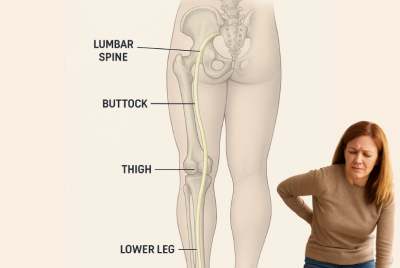Is Sciatica Hereditary
Is Sciatica Hereditary? Unraveling the Genetic Threads of a Painful Dilemma
Unlock the genetic mysteries: Is sciatica hereditary? Dive into our expert exploration and strategies for managing this familial nerve pain. Sciatica, a term often whispered in discomfort, conjures images of radiating pain down the leg and the challenge of navigating daily life with a persistent ache. As an advisor on sciatica, I embark on unraveling a pertinent question that echoes in the minds of many: Is sciatica hereditary? In this exploration, we’ll traverse the intricacies of genetic influences, the role of familial patterns, and the actionable steps individuals can take to understand and mitigate this often debilitating condition.
Decoding Sciatica in the Genetic Matrix
Introduction
Sciatica, a condition stemming from compression of the sciatic nerve, transcends its physical manifestations. It delves into the very fabric of our genetics, posing questions about hereditary factors that might contribute to its onset. To decipher this conundrum, let’s embark on a journey through the complex interplay of genes and sciatica.
Genetic Predisposition: A Crucial Piece of the Puzzle
Our genetic blueprint shapes not only our eye color and height but also influences our susceptibility to various health conditions. Sciatica, it seems, is no exception. Recent studies have pointed toward a potential genetic predisposition, hinting that our family trees might hold clues about our vulnerability to this nerve-wracking pain.
Examining Family Trees for Sciatic Shadows
Familial Patterns Speak Louder Than Words
Our family history often serves as a mirror reflecting our health trajectory. As we scrutinize the branches of our family tree, patterns may emerge – a grandparent who struggled with sciatic discomfort, an aunt who battled through the pain. Recognizing these familial echoes becomes a crucial step in understanding the potential hereditary nature of sciatica.
Genes vs. Lifestyle: The Tug of War
While genes lay the foundation, lifestyle choices add layers to the narrative. It’s essential to distinguish between genetic predisposition and lifestyle factors contributing to sciatica. Are we dealing with an inherited legacy, or is it the cumulative effect of sedentary habits and poor posture? The answer lies in parsing the threads of our unique genetic tapestry.
Navigating the Sea of Risk and Prevention
Assessing the Risk: Genetic Testing and Beyond
For those curious about their genetic vulnerability to sciatica, the realm of genetic testing beckons. Understanding the results, however, requires a holistic perspective. Genetic predisposition, when coupled with lifestyle modifications, unveils a roadmap to navigate the sea of risk and preemptively steer clear of sciatic storms.
Preventive Measures: Building Fortresses Against Sciatic Onslaught
Armed with genetic insights, proactive individuals can fortify themselves against a sciatic onslaught. Regular exercise, a cornerstone of preventive measures, strengthens the body and acts as a shield against the lurking genetic shadows. Lifestyle choices become not just personal preferences but strategic decisions in the battle against hereditary tendencies.
The Human Side of Sciatica: Personal Narratives and Coping Strategies
From Enthusiast to Survivor: A Personal Brush with Sciatica
In weaving the tale of sciatica, personal narratives take center stage as someone who has weathered the storm or witnessed its impact; sharing these stories is not just an exercise in empathy but a beacon of hope. Early interventions, lifestyle tweaks, and resilience become the protagonists in this tale of overcoming sciatic adversity.
Coping Strategies: Beyond the Pain
Coping with sciatica extends beyond physical discomfort. It’s a journey fraught with emotional and mental challenges. Integrating coping strategies, from mindfulness practices to stress reduction techniques, becomes a lifeline for those navigating the often turbulent waters of chronic pain.
Dispelling Myths, Building Awareness, and Seeking Professional Guidance
Mythbusters: Separating Fact from Fiction
In the realm of sciatica, myths often intertwine with truths, creating a tapestry of confusion. Dispelling these myths – be it misconceptions about hereditary factors or the efficacy of preventive measures – is crucial. Clarity paves the way for informed decisions and a deeper understanding of the condition.
Building Bridges of Awareness
Building awareness is not just an individual responsibility, but a collective endeavor. Educating communities, sharing knowledge about the hereditary aspects of sciatica, and providing resources empower individuals to take charge of their health. Awareness becomes a beacon of light in the often shadowy landscape of chronic pain.
FAQs About Sciatica and Genetics
Can sciatica skip a generation?
Sciatica doesn’t adhere to generational skips; its occurrence depends on a complex interplay of genetic and environmental factors. The hereditary component remains relevant across different age groups, challenging the notion of generational exclusion. Understanding these dynamics is crucial for unraveling the genetic threads of sciatic discomfort.
Is there a specific gene responsible for sciatica?
Ongoing research hasn’t identified a singular gene solely responsible for sciatica. Scientists are exploring a combination of genetic and environmental factors contributing to the condition. The quest for the specific gene continues, highlighting the intricate nature of the genetic landscape associated with sciatic nerve pain.
Can lifestyle changes overcome genetic predisposition to sciatica?
Yes, adopting a healthy lifestyle empowers individuals to overcome genetic predisposition to sciatica. Regular exercise and ergonomic practices play pivotal roles in mitigating the impact of genetic factors. Making proactive lifestyle changes becomes a potent strategy in steering away from the potential challenges posed by genetic susceptibility to sciatic discomfort.
Are there age-related factors in hereditary sciatica?
While age contributes to sciatica, the hereditary component remains significant across different age groups. Hereditary sciatica isn’t confined to specific age brackets, emphasizing the enduring relevance of genetic factors in its manifestation. Understanding these age-related dynamics is crucial for a comprehensive comprehension of sciatic nerve pain’s genetic dimension.
How can I discuss my family history of sciatica with my healthcare provider?
Openly communicate your family history of sciatica with your healthcare provider. Share detailed information, including symptoms experienced by relatives. This transparent dialogue aids your healthcare provider in assessing potential risks, guiding them in tailoring a personalized healthcare approach that considers the hereditary aspects of sciatica in your family history.
Conclusion: Navigating the Genetic Maze of Sciatica
In concluding our exploration, the hereditary aspect of sciatica is not a definitive sentence but a chapter in a broader narrative. Armed with genetic insights, personal experiences, and preventive measures, individuals can steer their health journey away from the ominous shadows of sciatic discomfort. It’s a journey that requires not just knowledge but resilience, bridging the gap between genetic predisposition and empowered living.
Disclaimer
Please note that the information provided in this article is for informational purposes only and should not replace professional medical advice. If you’re experiencing sciatica pain or any health concerns, it’s advisable to consult a healthcare professional for proper diagnosis and treatment.





